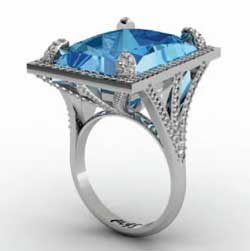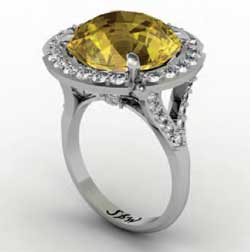|
All about Palladium I first came across palladium in the far off (heady, slim, bare-legged fun-filled) days of the days of early 70’s as a catalyst in electro-plating nickel onto ceramics in the electronics industry. All very boring… Today (hair-dye, dodgy knees and elasticated waists) palladium is a new and exciting metal rearing its head and roaring into the jewellery market. It was discovered in 1803 by called William Hyde Wollaston, who named it after the Greek Goddess of war and wisdom, Pallas Athene. It is found in South Africa, America, Canada and Russia. Part of the platinum family, palladium is a rare and precious metal (many, many times rarer than gold) with a bright, shiny, lustrous silvery-white finish. On its own, it is a beautiful metal, but it is also the perfect polished compliment to precious stones. Palladium is inert; it does nor corrode, oxidise or tarnish and this of vital importance to anyone with an allergy to nickel. Palladium has many industrial uses and, in the jewellery industry, palladium is now being used in gold alloys to make white gold. Unfortunately, nickel is much cheaper and does the same job acting as a whitening agent. Because of its presence, some people have experienced nickel intolerance when wearing some types of gold. However, these same people should be fine with palladium either in its pure form or in a gold alloy. 9ct and 18ct white gold naturally have a yellowish tinge. To overcome this, jewellery manufacturers have routinely plated pieces of jewellery with an extremely expensive metal: Rhodium. The usual plating thickness is 3 microns and when you consider a micron is a thousandth of a millimetre, this is a very thin layer indeed. During wear, especially on rings, rhodium can quickly wear off, leaving your jewellery looking rather sad with yellow tinges. There are now some 18ct white gold alloys with a high palladium content that eliminates the necessity to plate with rhodium and, of course, palladium itself requires no plating whatsoever. StrawberryWood can use any of these alloys for bespoke pieces, but its use is currently limited on the Je t’adore ranges. However, more and more manufacturers are seeing an increased demand for palladium, so much so, that in 2009 voluntary hall marking was introduced by the Assay offices and, in 2010, it became mandatory. Apart from its own glorious properties, palladium is much less costly than platinum, also it is much lighter in weight than platinum and gold, meaning lighter pieces of jewellery that are less costly to buy. All in all, palladium has everything going for it and I love using it. StrawberryWood |
|
Upcoming Events
-
Foody Friday
Friday 26th April, 16:00 - 18:00 -
Higham Ferrers Farmers Market
Saturday 27th April, 09:00 - 13:00 -
Stamp Fair
Saturday 27th April, 10:00 - 16:00 -
Finedon Over 60s Club
Wednesday 1st May, 13:30 - 15:30 -
The Addington’s Horticultural Socie...
Wednesday 1st May, 14:00



